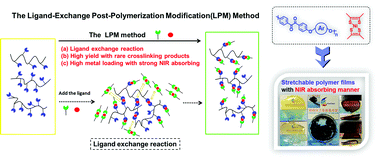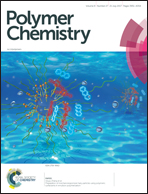Construction of flexible and stable near-infrared absorbing polymer films containing nickel-bis(dithiolene) moieties via ligand-exchange post-polymerization modification†
Abstract
Flexible and stable near-infrared (NIR) absorbing polymer films were prepared from the corresponding poly(aryl ether) precursors through subsequent ligand-exchange post-polymerization modification. The additional ligand triggers the ligand-exchange reaction during the post-polymerization modification process, which can significantly enhance the polymer yield, as well as the coordination ratio of the nickel-bis(dithiolene) segment in the polymer backbone by suppressing cross-linking side reactions. The presented ligand-exchange post-polymerization modification overcomes the limitations of the post-polymerization modification reaction, i.e. a high degree of cross-linking between the same reactive groups, and enhances the modification methods of analogous polymers. Upon incorporating the nickel-bis(dithiolene) moiety into the polymer backbone, the resulting polymers exhibit both strong near-infrared absorption at approximately 1200 nm with ε > 104 mol−1 L cm−1 in an NMP solution and excellent free-standing film formation properties. The long-term aging-resistance test indicates that the incorporation of the nickel-bis(dithiolene) moiety into the polymer chain via chemical bonding is superior to physical blending for stabilizing the nickel-bis(dithiolene) moiety. Although the absorbance of the micromolecular NIR dyes Ni–O and Ni–N at the maximum wavelength gradually decreased up to 34% during the aging test (70 °C for 144 h), it should be noted that the NiO-P6 (10 mol% nickel-bis(dithiolene) segments) and NiN-P8 (34 mol% nickel-bis(dithiolene) segments) polymer films exhibited no decrease in the NIR absorption range. Finally, this work shows that the post-polymerization modification between the same reactive groups could also be an effective approach to install functional groups in a polymer backbone while avoiding a high degree of cross-linking side reactions, as well as offers an approach to design near-infrared absorbing polymeric materials with balanced near-infrared absorption and solution-processing properties.



 Please wait while we load your content...
Please wait while we load your content...